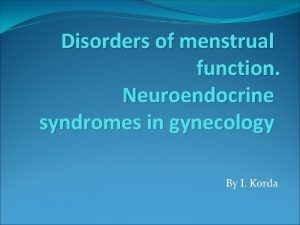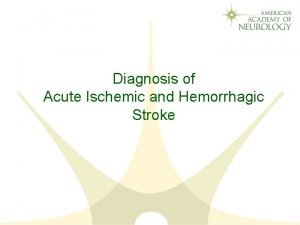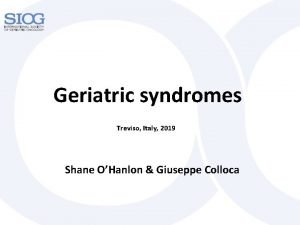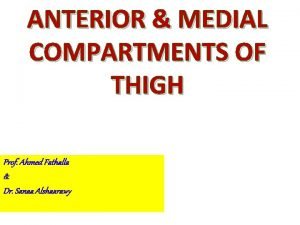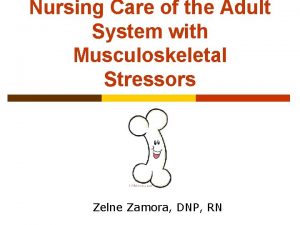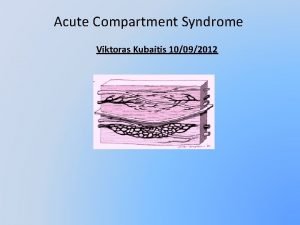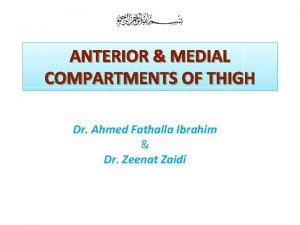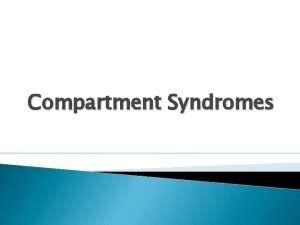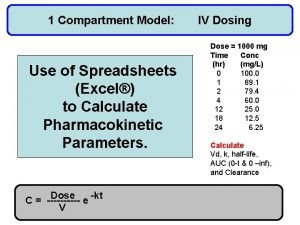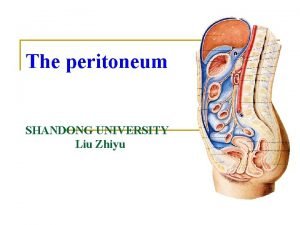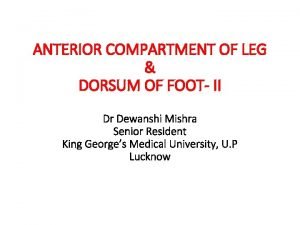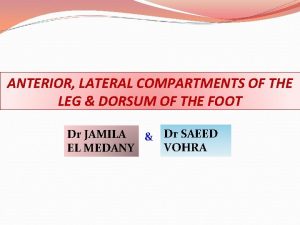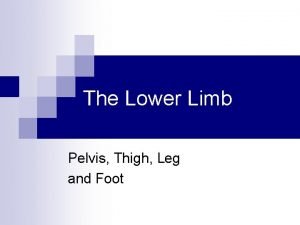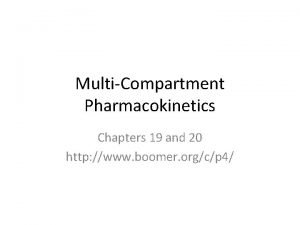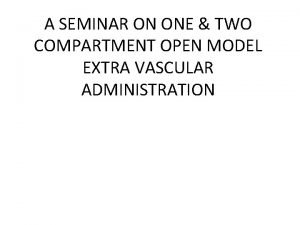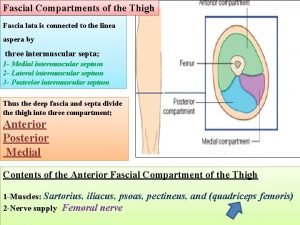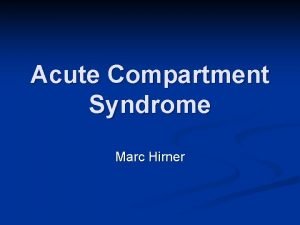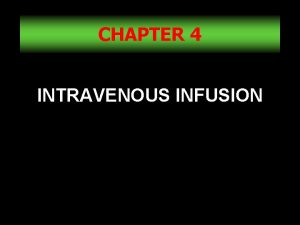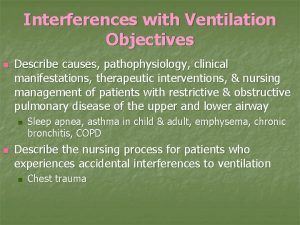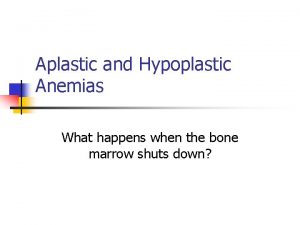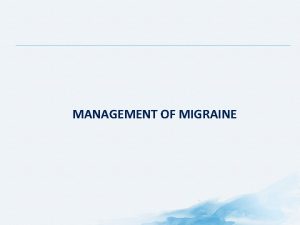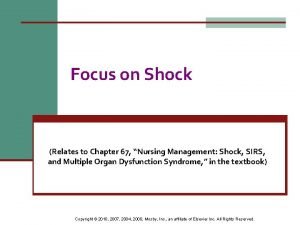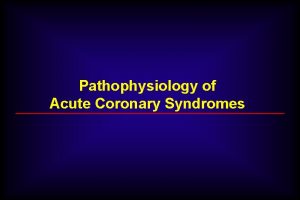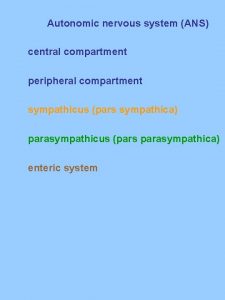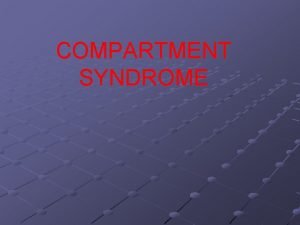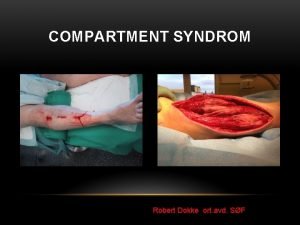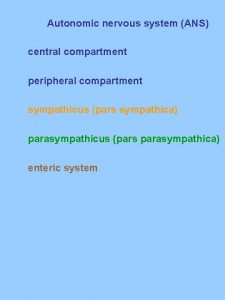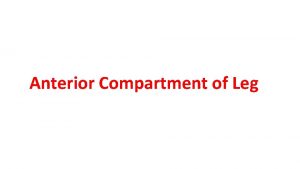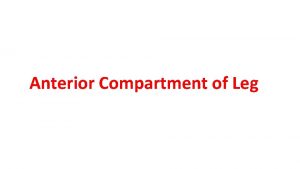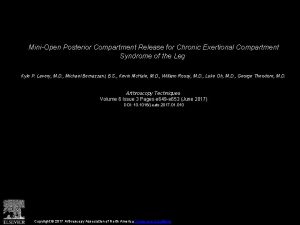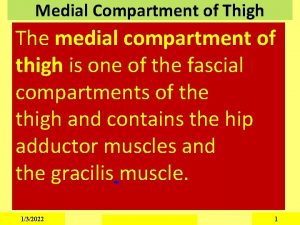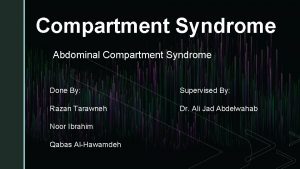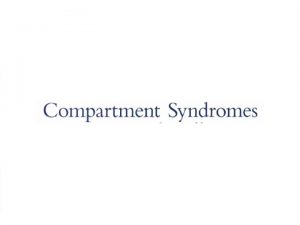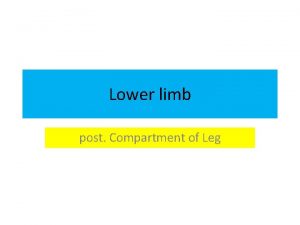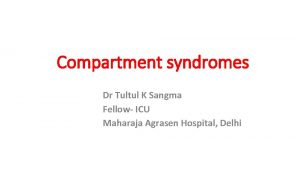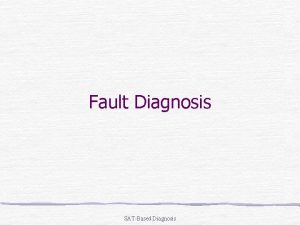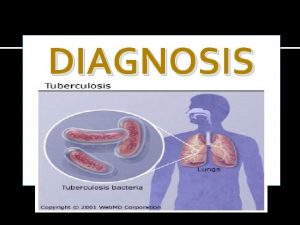Compartment Syndromes Today What is it Pathophysiology Diagnosis






































































- Slides: 70

Compartment Syndromes

Today � What is it � Pathophysiology � Diagnosis � Treatment

Increase in hydrostatic pressure in closed osteofascial space resulting in decreased perfusion of muscle and nerves within compartment

� RAISED PRESSURE WITHIN A CLOSED SPACE with a potential to cause irreversible damage to the contents of the closed space

Definition �Symptoms resulting from increased pressure within a limited space ◦ compromising �circulation �function

Pathophysiology �Local Blood Flow is reduced as a consequence: LBF=Pa-Pv / R (A-V Gradient)

Pathophysiology �A continuous increase in pressure within a compartment occurs until the low intramuscular arteriolar pressure is exceeded and blood cannot enter the capillaries

Pathophysiology �Increased compartment pressure Increased venous pressure Decreased blood flow Decreases

Pathophysiology � Autoregulatory compensate: mechanisms may ◦ Decrease in peripheral vascular resistance ◦ Increased extraction of oxygen � As system becomes overwhelmed: ◦ Critical closing pressure is reached ◦ Oxygen perfusion of muscles and nerves decreases

Muscle Ischemia � 4 hours - reversible damage � 8 hours - irreversible changes � 4 -8 hours - variable Hargens JBJS 1981

Muscle Ischemia �Myoglobinuria after 4 hours ◦ Renal failure ◦ Maintain a high urinary output ◦ Alkalinize the urine �Cell death initiates a “vicious cycle” ◦ increase capillary permeability ◦ increased muscle swelling

Increased muscle swelling Increased permeability Increased compartment pressure

�Increased pressure Increased venous pressure Decreased blood flow Decreases perfusion

Repetitive Cycle Increased muscle swelling Increased permeability Increased compartment pressure

Nerve Ischemia � 1 hour - normal conduction � 1 - 4 hours - neuropraxic damage reversible � 8 hours - axonotmesis and irreversible change Hargens et al. JBJS 1979

Pathophysiology: � CAUSES: � Increased Volume - internal : hemmorhage, fractures, swelling from traumatized tissue, increased fluid secondary to burns, post-ischemic swelling � Decreased � Most volume - external: tight casts, dressings common cause of hemmorhage into a compartment: fractures of the tibia, elbow, forearm or femur

Etiology �Fractures �Soft Tissue Injury (Crush) �Arterial Injury ◦ Post-ischemic swelling ◦ Reperfusion injury �Drug Overdose (limb compression) �Burns

Pathophysiology: Most common cause of compartment syndrome is muscle injury that leads to edema

Arterial Injuries � Secondary to revascularization: � Ischemia causes damage to cellular basement membrane that results in edema � With reestablishment of flow, fluid leaks into the compartment increasing the pressure

Diagnosis � Clinical diagnosis ◦ High index of suspicion � Syndrome ◦ History ◦ Physical Exam

Difficult Diagnosis signs of the 5 P’s - ARE NOT RELIABLE: � Classic ◦ ◦ ◦ pain pallor paralysis pulselessness paresthesias � These are signs of an ESTABLISHED compartment syndrome where ischemic injury has already taken place � These signs may be present in the absence of compartment syndrome.

Diagnosis � Pain � Compartment pressure ◦ Confirmatory test ◦ Don’t just measure

Diagnosis �Palpable pulses are usually present in acute compartment syndromes unless an arterial injury occurs �Sensory changes and paralysis do not occur until ischemia has been present for about 1 hour or more

Diagnosis most important symptom of an impending � The compartment syndrome is PAIN DISPROPORTIONATE TO THAT EXPECTED FOR THE INJURY

Signs & Symptoms �Pain ◦ Passive muscle stretching ◦ Out of proportion ◦ Progressive ◦ Not relieved by immobilization

Signs & Symptoms �Pain ◦ May be worse with elevation ◦ Patient will not initiate motion on own �Be careful with coexisting nerve injury

Signs & Symptoms �Parasthesia ◦ Secondary to nerve ischemia �Must be differentiated from nerve injury

Signs & Symptoms � Paralysis (Weakness) ◦ Ischemic muscles lose function

Signs & Symptoms � Tense compartment on palpation � Elevated compartment pressure

Tissue Pressure � Normal tissue pressure ◦ 0 -4 mm Hg ◦ 8 -10 with exertion � Absolute pressure theory � Pressure gradient theory ◦ 30 mm Hg - Mubarak ◦ 45 mm Hg - Matsen ◦ < 20 mm Hg of diastolic pressure – Whitesides ◦ < 30 mm Hg of diastolic pressure Mc. Queen, et al

Who is at high risk?

High energy fractures �Severe comminutio n �Joint extension �Segmental injuries �Widely displaced �Bilateral �Floating knee �Open fractures

Impaired Sensorium �Alcohol �Chemically unconscious �Neurologic �Decreased deficit GCS �Unconscious �Cognitively challenged �Drug

Diagnosis � � � The presence of an open fracture does NOT rule out the presence of a compartment syndrome 6 -9% of open tibial fractures are associated with compartment syndromes Mc. Queen et al found no significant differences in compartment pressures between open and closed tibial fractures � No significant difference in pressures between tibial fractures treated with IM Nails and those treated with Ex-Fix

Criteria-Compartment Pressure � Accurately examine ◦ Difference < 30 mm Hg � Impaired ◦ Absolute > than 30 mm Hg

Needle Infusion Technique-Historical � Needle inserted into muscle, tube with air/saline interval kept at this height, manometer indicates pressure � Air injected by syringe via 3 -way stopcock � When the pressure of the injected air exceeds the compartment pressure, the saline interval moves in the tube � AT this point, the second person reads the pressure from the manometer NEED 2 PEOPLE ! saline

Pressure Measurement � Infusion ◦ manometer ◦ saline ◦ 3 -way stopcock (Whitesides, CORR 1975) � Catheter ◦ wick ◦ slit catheter � Arterial line � Stryker device ◦ 16 - 18 ga. Needle (5 -19 mm Hg higher) ◦ transducer ◦ monitor ◦ Side port needle

Pressure Measurement � Needle ◦ 18 gauge ◦ Side ported � Catheter ◦ wick ◦ slit � Performed within 5 cm of the injury if possible. Whitesides, Heckman Side port

� Unit and needle set � Assemble unit and prime � Hold at angle to measure � Zero machine � Test each of 4 compartments ◦ Keep calf of bed

Most Common Locations deep posterior and the anterior compartments �Leg: volar compartment, especially in �Forearm: the deep flexor area

Where to Measure

Pressure � Deeper muscles are initially involved � Distance from fracture affects pressure Heckmen et al. JBJS 1994

Compartments �Anterior �Lateral �Posterior ◦ Deep ◦ Superficial

Compartments �Anterior �Lateral �Posterior ◦ Deep ◦ Superficial TA EDL EHL Peroneu s TP FHL Soleus Gastroc FDL

Treatment � Remove restricting bandages � Serial exams � When diagnosis made ◦ Immediate surgery � 4 compartment fasciotomy

Treatment THE ONLY EFFECTIVE WAY TO DECOMPRESS AN ACUTE COMPARTMENT SYNDROME IS BY SURGICAL FASCIOTOMY!!! (unless missed compartment syndrome)

Treatment �Fasciotomy ◦ One incision �With or without Fibulectomy ◦ Two incisions �All 4 compartments must be released ◦ Not selective

One Incision � Direct lateral incision

Perifibular Fasciotomy � One incision � Head of fibula to proximal tip of lateral malleolus � Incise fascia between soleus and FHL distally and extended proximally to origin of soleus from fibula � Deep posterior compartment released off of the interosseous membrane, approached from the interval between the lateral and superfical posterior compartments

� Lateral compartment

� Anterior compartment

Alternative Through intermuscular septum to reach superficial posterior compartment

Two incisions �Lateral �Medial


Double Incision � 2 vertical incisions separated by a skin bridge of at least 8 cm � Anterolateral Incision: from knee to ankle, centered over interval between anterior and lateral compartments

Double Incision � Posteromedial Incision: centered 1 -2 cm behind posteromedial border of tibia � Soleus must be detached from tibia in order to adequately decompress proximal portion of deep posterior compartment

Thigh � Rare � Crush injury with femur fracture � Over distraction ◦ relative under distraction

Thigh �Quadriceps ◦ Lateral �Hamstrings ◦ Posterior �Abductor ◦ Medial

Treatment �Based upon involvement �Usually Quadriceps and Hamstrings �Usually, a single lateral incision will suffice

Compartments of the Forearm �Forearm can be divided into 3 compartments: Dorsal, Volar and “Mobile Wad” �Mobile Wad: Brachioradialis, ECRL, ECRB �Dorsal: EPB, EPL, ECU, EDC �Volar: FPL, FCR, FCU, FDS, FDP, PQ

Henry Approach � Incision begins proximal to antecubital fossa and extends across carpal tunnel � Begins lateral to biceps tendon, crosses elbow crease and extends radially, then it is extended distally along medial aspect of brachioradialis and extends across the palm along thenar crease � Alternatively, a straight incision from lateral biceps to radial styloid can be used.

Henry Approach � Fascia over superficial muscles is incised � Care of NV structures

Henry Approach � Brachioradialis and superficial radial n. are retracted radially and FCR and radial artery are retracted ulnar to expose the deep volar muscles � Fascia of each of the deep muscles is then incised

Post Fasciotomy… �Must get bone stability ◦ IMN ◦ exfix �~48 hrs after procedure patient should be brought back to OR for further debridement �Delayed skin closure or skingrafting 3 -7 days after the fasciotomies

Aftercare � Xeroform � VAC dressings � Elevation of limb � Delayed wound closure ◦ Split thickness skin graft

Remember… � Fasciotomies are not benign � Complications are real >25% ◦ ◦ ◦ Chronic swelling Chronic pain Muscle weakness Iatrogenic NV injury Cosmetic concerns *** BUT if they are needed do not come up with excuses to not do them !!!

Chronic (Exertional) Compartment Syndrome �Transient rise in compartmental pressure following activity �Symptoms ◦ Pain ◦ Weakness ◦ Neurologic deficits

Chronic Compartment Syndrome �Stress Test ◦ Serial Compartment Pressure �Resting >15 mm Hg � 5 min post-ex. >25 mm Hg � Rydholm et al CORR 1983 ◦ Volumetrics ◦ Nerve conduction Velocities �Pedowitz et al. JHS 1988

Chronic Compartment Syndrome Treatment � ◦ Modification of activity ◦ Splinting ◦ Elective Fasciotomy

Conclusion � Very important to make diagnosis � Missed compartment is devastating � Physical exam � Re-examine patient!
 Neuroendocrine syndromes in gynecology
Neuroendocrine syndromes in gynecology Brainstem stroke syndromes
Brainstem stroke syndromes Neuroendocrine syndrome in gynecology
Neuroendocrine syndrome in gynecology Cerebellaris
Cerebellaris What is geriatric syndromes
What is geriatric syndromes Cerebellar syndromes
Cerebellar syndromes Collaborative interventions nursing
Collaborative interventions nursing Perbedaan diagnosis gizi dan diagnosis medis
Perbedaan diagnosis gizi dan diagnosis medis Medical diagnosis and nursing diagnosis difference
Medical diagnosis and nursing diagnosis difference Nursing diagnosis three parts
Nursing diagnosis three parts Nursing process and critical thinking
Nursing process and critical thinking Proposal kickoff meeting agenda
Proposal kickoff meeting agenda Today's lesson or today lesson
Today's lesson or today lesson Today lesson or today's lesson
Today lesson or today's lesson For today's meeting
For today's meeting In todays lesson
In todays lesson Today's lesson or today lesson
Today's lesson or today lesson Base of thigh
Base of thigh Greater sac of peritoneum
Greater sac of peritoneum Body fluid compartment
Body fluid compartment Bucks traction weight
Bucks traction weight Compartment syndrome 7p
Compartment syndrome 7p Class e cargo compartment
Class e cargo compartment Gastrocnemius origin and insertion
Gastrocnemius origin and insertion Peritoneum
Peritoneum Outer compartment of mitochondria
Outer compartment of mitochondria Sphenomandibular ligament origin and insertion
Sphenomandibular ligament origin and insertion Femoral triangle contents
Femoral triangle contents Extensor pollicis longus location
Extensor pollicis longus location Shattered dvd9
Shattered dvd9 Master cleaning schedule servsafe
Master cleaning schedule servsafe Mobile wad of henry
Mobile wad of henry L
L Compartment formula in excel
Compartment formula in excel Compartment fire
Compartment fire Fantail of a ship
Fantail of a ship Is the uterus intraperitoneal
Is the uterus intraperitoneal Przywodziciele uda
Przywodziciele uda Michelson water reclamation plant
Michelson water reclamation plant Anterior tibial artery
Anterior tibial artery Transcellular fluid compartment
Transcellular fluid compartment Renata pecova
Renata pecova What image is this
What image is this Compartment fire behavior training
Compartment fire behavior training Tibiali anterior
Tibiali anterior Boundary line between lower limb and pelvis
Boundary line between lower limb and pelvis Class e cargo compartment
Class e cargo compartment Compartment fire behavior training
Compartment fire behavior training Multi compartment model pharmacokinetics
Multi compartment model pharmacokinetics Peritoneum serous membrane
Peritoneum serous membrane Extensors leg
Extensors leg One compartment open model extravascular administration
One compartment open model extravascular administration Brachialis nerve supply
Brachialis nerve supply Compartment of bag technique
Compartment of bag technique Biceps femoris innervation
Biceps femoris innervation Compartment kiln seasoning
Compartment kiln seasoning Mark hirner
Mark hirner Iv infusion one compartment model
Iv infusion one compartment model Air seasoning advantages and disadvantages
Air seasoning advantages and disadvantages Intracellular fluid and extracellular fluid examples
Intracellular fluid and extracellular fluid examples Adductor pollicis longus tendon
Adductor pollicis longus tendon Asthma pathophysiology
Asthma pathophysiology Pathophysiology of pulmonary hypertension
Pathophysiology of pulmonary hypertension Aplastic anemia lab findings
Aplastic anemia lab findings Stage ckd
Stage ckd 3392chest
3392chest Pathophysiology of syphilis
Pathophysiology of syphilis Nursing management of pancreatitis
Nursing management of pancreatitis Pathophysiology of asthm
Pathophysiology of asthm Osteopern
Osteopern Cardiogenic shock
Cardiogenic shock
